There are approximately 9,800 FDIC-insured institutions with estimated insured deposits of about $3 trillion.
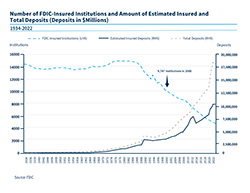
Chart of the number of FDIC-insured institutions and amount of estimated insured and total deposits - 2000
July 21, 2001

August 29, 2001
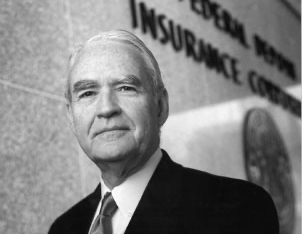
June, 2004
The Basel II capital framework is published, and is designed to improve the manner in which capital requirements reflect underlying risk and to take into account financial innovation. The framework comprises three elements: further-developed minimum capital requirements, supervisory reviews of institutions’ capital adequacy and their internal assessment process, and effective use of disclosure to strengthen market discipline and encourage sound banking practices
November 16, 2005
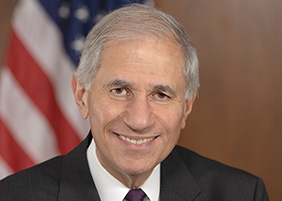
February 6, 2006
The Federal Deposit Insurance Reform Act of 2005 is signed into law by President George W. Bush.
This law makes several significant changes to the FDI Act; among them are:
- Merging the Bank Insurance Fund (BIF) and the Savings Association Insurance Fund (SAIF) effective March 31, 2006. The two funds, administered by the FDIC, were created in 1989 by FIRREA. The merged fund will be named the Deposit Insurance Fund (DIF).
- Changing the deposit insurance coverage limits, providing for the indexing of the standard coverage limit for inflation, and increasing the coverage limit for retirement accounts from $100,000 to $250,000.
- Reforming the FDIC's risk-based assessment system at the FDIC's recommendation, so that the FDIC can charge premiums based on risk to all insured institutions.
- Providing, the FDIC, again at the agency's recommendation, with more flexibility in setting the Designated Reserve Ratio ([DRR]--the fund balance divided by total estimated industry deposits). This had been set at 1.25 percent by statute in 1989 but can now be set between 1.15 and 1.5 percent.
- Providing insured institutions that had contributed to recapitalizing the insurance funds after the crisis that ended in 1994 with a one-time assessment credit.
For more information on the Federal Deposit Insurance Reform Act of 2005
For the development of the FDIC's risk-based assessment system as a result of the law's changes, see FDIC Annual Report, 1993, 10-15, https://www.fdic.gov/about/financial-reports/reports/archives/fdic-ar-1993.pdf .
June 26, 2006

2007
With the passage of the Federal Deposit Insurance Reform Act in 2006, the FDIC changes its risk-based assessment system to allow all banks to be charged a risk-based premium. In addition, the FDIC creates a system with four risk-based pricing categories, creates separate pricing methods for large and small banks, revises its method of differentiating risk among banks in the lowest risk category, and changes the treatment of new institutions for assessment purposes. The changes limited the subsidization of riskier institutions by safer ones and made assessments more sensitive to risk.
For details, see Edward Garnett, LaVaughn Henry, Daniel Hoople, and Ashley Mihalik, “A History of Risk-Based Premiums at the FDIC,” (Staff Study 2020-01, FDIC, January 2020), 7-15, https://www.fdic.gov/analysis/cfr/staff-studies/2020-01.pdf .
April 2. 2007
New Century Financial Corporation, the largest independent U.S. provider of subprime mortgages (home loans to people with poor credit histories) fires more than half its workforce and files for Chapter 11 bankruptcy. The company’s loan originations had risen from $14 billion in 2002 to $60 billion in 2006. The bankruptcy trustee described its business practices as having “elevated …risks to dangerous and ultimately fatal levels.”
December 12, 2007
The Federal Reserve, in an effort to provide liquidity to depository institutions, establishes the Term Auction Facility (TAF). Bank funding markets, particularly short-term funding markets, experienced severe difficulties because investors were reluctant to lend, and many banks were reluctant to borrow from the Federal Reserve’s discount window for fear that it would be perceived as weakness. The TAF initially provides 28-day loans to sound depository institutions.
January 11, 2008
Bank of America announces that it will purchase Countrywide Financial Corporation, a $100 million asset thrift and leading originator of subprime mortgages, for $4 billion.
March 11, 2008
The Federal Reserve announces the creation of the Term Securities Lending Facility (TSLF). The program was a result of concern that primary dealers (banks and broker-dealers authorized to deal directly in government bonds) might not be able to fund themselves in short-term funding markets. The TSLF authorized the Federal Reserve Bank of New York to lend primary dealers up to $200 billion in short-term U.S. Treasury securities against eligible collateral. The program was closed on February 1, 2010.
https://elischolar.library.yale.edu/journal-of-financial-crises/vol2/iss3/8/
https://www.federalreserve.gov/monetarypolicy/tslf.htm
March 16, 2008
The Federal Reserve authorizes the Federal Reserve Bank of New York to create the Primary Dealer Credit Facility to aid market liquidity. This lending facility is designed to improve the ability of primary dealers to provide financing to those engaged in the securitization markets.
March 24, 2008
JPMorgan Chase acquires Bear Stearns, the fifth-largest investment bank in the United States, with government assistance. The Federal Reserve Bank of New York will provide financing to facilitate the transaction and creates a limited liability company called Maiden Lane to handle the financing. Bear Stearns had declared bankruptcy for two of its funds that invested in subprime securities on July 31, 2007.
July 11, 2008
IndyMac Bank, a California thrift with total assets of $31 billion, fails. The bank had pursued aggressive growth and became the seventh-largest savings association in the nation. The bank originated loans for the purpose of selling them (originate-to-sell); originated many so-called no- and low-doc loans, loans without full verification of the borrower’s income or assets; and concentrated its business in high-risk loans. The Office of Thrift Supervision placed the bank into conservatorship and named the FDIC conservator. All non-brokered insured deposits were transferred to a newly created institution, IndyMac Federal Bank, F.S.B. The failure will become one of the costliest in FDIC history, with estimated losses of about $12 billion.
September 7, 2008
The Federal Housing Finance Agency places Fannie Mae and Freddie Mac, two government-sponsored enterprises (GSEs) that securitized a large amount of U.S. mortgages with about $1.5 trillion in outstanding bonds, in government conservatorship to prevent them from failing. The U.S. Treasury would eventually support the two GSEs with a total investment of $189.5 billion.
September 15, 2008
Lehman Brothers Holdings Inc. files for bankruptcy protection. Lehman had pursued an aggressive growth strategy, investing in long-term high-risk areas and continued to do so even as the subprime crisis grew. By early 2008, the firm began to raise equity and seek investment partners, and, eventually, acquirers, as its liquidity problems became acute. Although several firms considered acquiring Lehman, none did. After Lehman reported further losses on September 10, the firm’s counterparties lost confidence in Lehman, withdrew short-term funding and demanded more collateral. With no willing acquirer, Lehman filed for Chapter 11 bankruptcy. On the same date, Bank of America, which had considered and rejected acquiring Lehman, announces its intent to purchase Merrill Lynch & Co.
https://www.fdic.gov/analysis/quarterly-banking-profile/fdic-quarterly/2011-vol5-2/lehman.pdf
September 16, 2008
AIG obtains a temporary liquidity facility from the Federal Reserve Bank of New York. AIG, a large insurance company, had liquidity problems due to losses on its mortgage-related investments, various financial derivatives, and contracts, and its failure was imminent. Policymakers believed the consequences of such a failure posed a severe threat to an already-precarious situation in financial markets. The Federal Reserve authorized the Federal Reserve Bank of New York to loan up to $85 billion to AIG, and the company agreed to transfer a controlling stake in the company to the U.S. Treasury.
The Reserve Primary Fund, a $62 billion money market fund, announces it “broke the buck,” re-pricing its shares at $0.97. The fund held $785 million of Lehman’s commercial paper. After the Lehman bankruptcy filing, the Reserve Primary Fund immediately experienced a run and was forced to sell securities to meet redemption requests, furthering depressing valuations.
September 19, 2008
The U.S. Treasury announces that it will temporarily guarantee money market funds against losses, using the approximately $50 billion in the U.S. government's Exchange Stabilization Fund. This decision was made after the Reserve Primary Fund “broke the buck” following the Lehman bankruptcy and as money market funds experienced approximately $310 billion in withdrawals (about 15 percent of their total assets).
https://www.treasury.gov/press-center/press-releases/pages/hp1161.aspx
September 21, 2008
Goldman Sachs and Morgan Stanley become bank holding companies (BHCs) regulated by the Federal Reserve. The decision is intended to provide them the benefit of market perceptions that such oversight strengthens financial institutions and to allow these institutions access to liquidity and financing facilities, such as the Federal Reserve’s discount window, available only if the institutions become BHCs.
https://www.goldmansachs.com/our-firm/history/moments/2008-bank-holding-company.html
September 25, 2008
Washington Mutual Bank (WaMu), with assets of $307 billion, fails, the largest failure in FDIC history. The bank had pursued a high-risk lending strategy, with weak underwriting standards and inadequate risk controls. This strategy and the housing and mortgage market dislocations in 2007 contributed to large loan losses for WaMu. Depositors withdrew significant funds after other high-profile financial institution failures and rumors circulated about WaMu’s condition, prompting the Office of Thrift Supervision to close the bank. JPMorgan Chase acquired its deposits and assets in a transaction that had no cost to the Deposit Insurance Fund.
September 29, 2008
A systemic risk exception is recommended and approved for Citigroup to acquire Wachovia Corporation, the fourth-largest bank in the nation by assets. The deal is announced but never completed because Wells Fargo would acquire the bank several days later under terms that required no assistance from the FDIC and provided a higher price for Wachovia’s shareholders.
Wachovia had been having difficulty meeting its liquidity needs, and the failure of WaMu added to concerns among depositors and other creditors. On September 26, the bank notified its lead federal supervisor (the OCC) that it would be unable to obtain the funds needed to pay creditor claims, but federal regulators and policymakers assessed that a standard “least-cost” resolution of the bank would have systemic consequences for the financial system.
See FDIC, Crisis and Response: An FDIC History, 2008-2013 (2017), chap. 3. https://www.fdic.gov/resources/publications/crisis-response/book/crisis-response-chapter-3.pdf
October 3, 2008
The Emergency Economic Stabilization Act of 2008 is signed into law by President George W. Bush. The law authorizes the $700 billion Temporary Asset Relief Program (TARP) and temporarily increases deposit insurance coverage to $250,000.
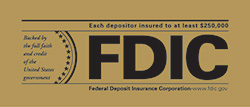
Image of the FDIC $250,000 Deposit Insurance Coverage Limit Sign
October 3, 2008
Wells Fargo announces that it will acquire Wachovia.
https://www.federalreserve.gov/newsevents/testimony/alvarez20100901a.htm
October 14, 2008
The FDIC announces that a systemic risk exception was approved, permitting the agency to create the Temporary Liquidity Guarantee Program (TLGP). The TLGP has two parts: the Debt Guarantee Program (DGP) and the Transaction Account Guarantee Program (TAGP). For the first time in its history, the FDIC will guarantee something other than deposits; under the DGP, the FDIC will guarantee $618 billion in bank debt during the program’s life. Also for the first time in history, under the TAGP, the FDIC will provide unlimited deposit insurance, though to a subset of transaction account types that paid little or no interest.
At the same time, the Federal Reserve announces the creation of the Commercial Paper Funding Facility (CPFF), and the U.S. Treasury announces the Capital Purchase Program (CPP) under the TARP. The CPFF was created to provide liquidity to U.S. issuers of commercial paper and improve liquidity in short-term funding markets. The program expired on February 1, 2010. The CPP was created to stabilize the banking system by bolstering the capital position of viable financial institutions. By the end of the program, it would provide approximately $205 billion in capital to 707 institutions. The U.S. Treasury received preferred stock or debt securities in exchange for the capital infusions.
See FDIC, Crisis and Response: An FDIC History, 2008–2013 (2017), chap. 2. https://www.fdic.gov/resources/publications/crisis-response/book/crisis-response-chapter-2.pdf
https://home.treasury.gov/data/troubled-assets-relief-program/bank-investment-programs/cap/overview
https://www.newyorkfed.org/medialibrary/media/research/epr/11v17n1/1105adri.pdf
October 28, 2008
The U.S. Treasury announces that under the Capital Purchase Program it has $125 million in purchased preferred stock in nine of the largest U.S. financial institutions holding approximately 45 percent of U.S. insured depository institutions' assets. The nine institutions were: Bank of America Corporation; Citigroup, Inc.; JPMorgan Chase & Co.; Wells Fargo & Company; Morgan Stanley; The Goldman Sachs Group, Inc.; The Bank of New York Mellon Corporation; State Street Corporation; and Merrill Lynch & Co, Inc.
November 23, 2008
A systemic risk exception is recommended and approved for assistance to Citigroup, one of the largest financial institutions in the world, with assets of just over $2 trillion and about $1.2 trillion in assets in Citibank, N.A. Despite substantial government support through the TARP, Federal Reserve lending, and the FDIC's Debt Guarantee Program, the company's financial condition had continued to deteriorate. Given its size and interconnectedness, its failure presented a serious systemic risk, and so an open-bank assistance package was assembled that included a $20 billion capital injection by the Treasury and loss protection on a $306 billion pool of Citigroup's assets, backed by the Treasury, the FDIC, and the Federal Reserve Bank of New York. In return, Citigroup issued $7 billion in stock and warrants to the Treasury and the FDIC.
See FDIC, Crisis and Response: An FDIC History, 2008-2013 (2017), chap. 3. https://www.fdic.gov/resources/publications/crisis-response/book/crisis-response-chapter-3.pdf
December 31, 2008
By year-end, 25 insured depository institutions have failed, and the number of problem institutions has risen from 76 a year earlier to 252

Chart of the number of bank and thrift failure and assistance transactions in the United States
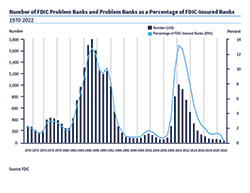
Chart of the number of problem banks and problem banks as percentage of FDIC-insured banks
January 1, 2009
The FDIC increases deposit insurance assessment rates by 7 basis points. During the second half of 2008, estimated losses from failures and reserves set aside for anticipated failures increased, and the fund balance and reserve ratio continued to decline. In response, in October 2008, the FDIC had proposed an increase in assessment rates for all banks, which becomes effective in first quarter 2009.
Bank of America completes its acquisition of Merrill Lynch, which it had announced in September 2008.
January 16, 2009
A systemic risk exception is announced to provide open-bank assistance to Bank of America Corporation. Its largest bank subsidiary, Bank of America, N.A., is the second largest bank in the nation with $1.5 trillion in assets. Bank of America's acquisitions of both Countrywide Financial and Merrill Lynch, meant that it absorbed significant losses. Federal regulators and the Treasury were concerned that Bank of America's failure would have systemic consequences. Bank of America was to receive an assistance package similar to the one provided to Citigroup in November 2008, with a capital injection from the Treasury through the TARP, $10 billion in loss protection on a pool of the bank's assets provided by the Treasury and the FDIC, and a nonrecourse loan from the Federal Reserve Bank of New York to cover 90 percent of losses over $21.1 billion. However, before the assistance is provided and before the systemic risk exception (SRE) is formally approved by the Secretary of the Treasury, Bank of America asks to terminate the package. The SRE is never consummated. Ultimately, Bank of America pays $425 million, essentially for receiving the benefit of the announced assistance.
See FDIC, Crisis and Response: An FDIC History, 2008-2013 (2017), chap. 3. https://www.fdic.gov/resources/publications/crisis-response/book/crisis-response-chapter-3.pdf
May 20, 2009
President Barack Obama signs Public Law 111-22.
Among its provisions, the law extends until year-end 2013 the temporary increase in deposit insurance coverage levels put in place in 2008 that were originally to expire at year-end 2009.
The law also increases the FDIC’s borrowing authority from $30 billion to $100 billion. In addition, it provides that the FDIC, upon a minimum two-thirds vote of its Board of Directors, a two-thirds vote of the Board of Governors of the Federal Reserve System, and the approval of the Secretary of the Treasury in consultation with the President, could borrow more than $100 billion, not to exceed $500 billion. This provision is temporary and expires on December 31, 2010.
See Sec. 204 of the law at https://www.congress.gov/111/plaws/publ22/PLAW-111publ22.pdf .
May 22, 2009
The FDIC announces a special assessment of 5 basis points to be levied on insured institution assets minus tier-one capital, capped at 10 basis points of an institution’s domestic deposits, to be collected on September 30, 2009. By using this method of assessment, the allocation of the assessment shifts to banks that rely more on nondeposit funding. The assessment will raise $5.5 billion and increase the DIF balance.
https://www.fdic.gov/news/press-releases/2009/pr09074.html
FDIC, Crisis and Response: An FDIC History, 2008-2013 (2017) https://www.fdic.gov/resources/publications/crisis-response/index.html.
May 31, 2009
Your Bank Has Failed: What Happens Next? - The FDIC was featured on CBS 60 Minutes on May 31, 2009, taking over a failed bank.
September 1, 2009
The FDIC extends the Transaction Account Guarantee Program (TAGP), which was originally scheduled to expire in December 2009, to June 30, 2010.
September 21, 2009
Bank of America terminates the proposed systemic risk exception assistance agreement announced on January 16, 2009.
September 29, 2009
The FDIC proposes a novel approach to address the DIF's liquidity needs, in which insured institutions prepay on December 30, 2009, their quarterly risk-based assessments for fourth quarter 2009 and for all of 2010, 2011, and 2012. In contrast to a special assessment, a prepaid assessment did not affect a bank's earnings or capital under accounting rules. The prepayment was counted on bank balance sheets as an asset that was reduced each quarter as each prepaid assessment became due. The prepaid assessment, in contrast to the FDIC borrowing from the Treasury, meant that the DIF remained funded by the banking industry and did not incur the interest costs that borrowing would have entailed. The FDIC finalizes the proposal on November 12, 2009, and collects the assessment, which realizes approximately $45.7 billion for the DIF on December 30.
https://www.fdic.gov/news/press-releases/2009/pr09203.html
September 30, 2009
The DIF balance and reserve ratio become negative for the first time since the early 1990s.
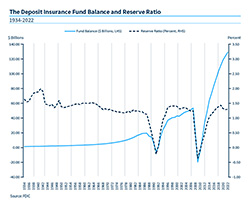
Chart of the FDIC Deposit Insurance Fund Balance and Reserve Ratio
October 31, 2009
The FDIC's Debt Guarantee Program (DGP) expires, but debt guaranteed by the DGP remains outstanding until year-end 2012.
December 31, 2009
The FDIC extends the Transaction Account Guarantee Program (TAGP) to December 31, 2010, when the program ends.
2009
By year-end, 140 insured depository institutions fail, and at year-end the number of problem institutions has risen to 702.

Chart of the number of bank and thrift failure and assistance transactions in the United States

Chart of the number of problem banks and problem banks as percentage of FDIC-insured banks
